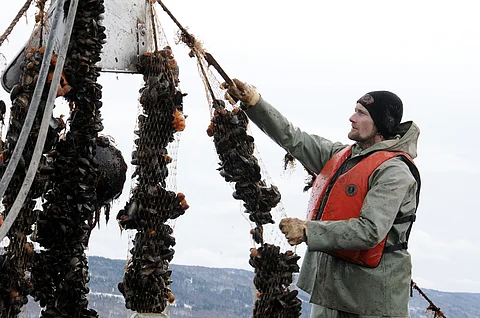

Nova Scotia now has a new mapping tool that helps identify the suitability of coastal areas for aquaculture development.
Photo: Province of Nova Scotia / File.
The Government of Nova Scotia announced that its new mapping tool to help identify the suitability of coastal areas for aquaculture development is now available. By providing access to consistent province-wide data, the so-called 'Aquaculture Coastal Classification System' supports both early planning and public awareness, thus supporting sea farming growth.
"Aquaculture is a key economic growth opportunity for Nova Scotia," said Kent Smith, Minister of Fisheries and Aquaculture for Nova Scotia (NS). "Access to scientific data provides the aquaculture industry greater confidence in choosing suitable areas for aquaculture development, supporting responsible growth and contributing to coastal communities," he added.
Developed in partnership with the Centre for Marine Applied Research, an independent division of Perennia Food & Agriculture Corporation, the provincial agriculture development agency, the 'Aquaculture Coastal Classification System' is a response to a recommendation from the 2015 Doelle-Lahey Report, which called for more transparent, science-based planning tools to support responsible aquaculture development in Nova Scotia.
To determine where coastal conditions may present more - or fewer - challenges for aquaculture development, the tool includes data related to conditions such as water depth and temperature, distance to marine protected areas, and navigation routes in Nova Scotia.
Supported by federal and provincial agencies, project-specific committees, and the Nova Scotia aquaculture science advisory committee, the publicly available information tool rates suitability for species such as oysters, mussels, salmon, and trout farming.
However, from the Government of Nova Scotia, they also remarked that the coastal classification system supports early planning, but it is not designed for specific site selection, nor is it a substitute for formal review or site-level assessment, and it is certainly not a substitute for the aquaculture licensing process, which would include public input.
Jeff Bishop, Executive Director of the Aquaculture Association of Nova Scotia (AANS) - formed more than 40 years ago to develop and support the production of quality farmed seafood by current and future aquaculturists in NS - commented on what this new mapping tool could mean for aquaculture in the Canadian Atlantic province.
"Data sets and information resources are key for decision making in business – and the aquaculture business is no different. This new coastal classification tool pulls together a number of these technical resources – and starts to inform someone looking to start or expand an existing aquaculture business in Nova Scotia," he said.
"Choosing the best accessible, growing areas for our farms is part of responsible, sustainable growth in aquaculture. And it means putting meals on the tables of Nova Scotians for years to come, " Jeff Bishop added.
The 'Aquaculture Coastal Classification System' is another example of Nova Scotia's strong commitment to aquaculture development in its territory. It joins other important measures such as, for example, the first Aquaculture Development Area, which, located in Argyle, Yarmouth County, includes pre-approved sites for growing shellfish and marine plants from which, in addition to seafood products, scientific data will also be collected.
The aquaculture industry employs almost 800 people and generates about CAD 120 million every year for Nova Scotia's economy.
